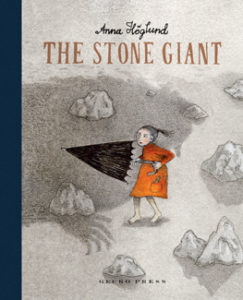 Anna Höglund is one of Sweden’s leading illustrators. She is the author of over 20 books, and her artwork is featured in the Gothenburg Museum of Art and the National Museum in Stockholm.
Anna Höglund is one of Sweden’s leading illustrators. She is the author of over 20 books, and her artwork is featured in the Gothenburg Museum of Art and the National Museum in Stockholm.
Anna is the author and illustrator of The Stone Giant.
 What fairytales were most important to you in childhood?
What fairytales were most important to you in childhood?
There are stories that stick with me. The Snow Queen by Hans Christian Andersen is one, and the one I based The Stone Giant on by Elsa Beskow—a fairytale called Tripp, Trapp, Trull och j’tten Dum-dum. I have changed the story in my head over the years but its core is the same. For me it is about the importance of survival and protection of the inner self. It also reminds us that it is always possible to fool oppressors, such as a cold parent or authoritarian teacher.
How does your own childhood influence your writing?
Almost everything I do is about identity and a desire for some kind of truth. I often use
emotions from childhood and youth, rarely specific events. What I remember most clearly
from childhood is dreams and fantasies—especially some nightmares. But also a very strong
connection to nature—some special flowers, trees and stones. I can still see them.
It is interesting to think about why we remember what we remember and why these memories
continue to pop up. It is fascinating how children play, choose books and make up their own
stories to suit their needs. They are processing, understanding or preparing for something in life.
What made you want to illustrate children’s books?
Reading, writing and drawing have always been my lifeline. I published my first picture book
at the age of 20, thinking it would be a good way to fund my painting career. I was terribly
disappointed by the financial outcome, but all I wanted to do after that was to create picture
books. For me it’s the ultimate form of expression.
Freud claimed that the very first language is verbal. That as soon as we receive the verbal
language, we translate all previous impressions from the pre-verbal period into words. I am not sure if this applies to everyone though. For me, the idea can still manifest itself as a picture book
when dealing with things that are more difficult to understand . . .
I have been making picture books for a very long time and I am happy about how perceptions of
them have changed. Thanks to the graphic novel and to artists like Maira Kalman and Shaun Tan,
picture books can address all ages, not just children.
How did you make the illustrations for this book? What is your process?
I always try to find a technique suitable for the pictures in the particular story I’m working on.
This time I was having a project year working on engravings. While I was making a dry point
etching of an island, Elsa Berkow’s story came back to me and it was clear my illustrations for the
story should be engravings. The very time-consuming old technique was what I was looking for
as a contrast with the outer world.

